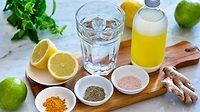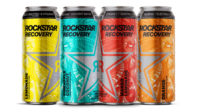Cover Feature
Consumers interest in functional beverages spans across globe
Energy, immune support among top attributes consumers desire

Image courtesy of Mountain Dew
Throughout history, humans have turned to drinks for more than just quenching thirst. From the Middle Ages to the Age of Enlightenment and beyond, beverages such as wine and spirits, beer, tea, coffee, soda and more have played important roles in human culture.
In the modern-days of the 21st century, as few subjects are more emotive than personal health, experts note that functional beverages are witnessing explosive growth as more consumers look to drinks that support their well-being.
In its article, titled “Seeking immunity in functional beverages,” Atlanta-based Innova Market Insights notes that today’s functional beverages make up a solid percentage of total launches of soft drinks, hot drinks and dairy drinks.
“A stronger immune system is highly desirable,” it states. “In fact, the COVID-19 pandemic shifted emphasis in functional beverages from performance benefits such as alertness to immune system benefits. Consumer interest in immunity spans the globe.
“In India and Indonesia, for example, immunity is the most important functional property ― nearly half of consumers surveyed want to purchase products for their immune benefits,” it continues. “Immunity is the second most desired health benefit in Germany and is among the Top 5 benefits named by consumers in several other countries.”
Meanwhile, the global functional beverage market is projected to register a CAGR of 7.5% during the forecast period 2022-2027, according to Mordor Intelligence, Hyderabad, India.
In its recent report “Functional Beverage Market - Growth, Trends, COVID-19 Impact, And Forecasts (2022 - 2027),” the market research firm notes that, with the impact of COVID-19, the market has witnessed a surge in demand for products that provide functional benefits, such as immune health.
“Consumers are increasingly seeking functional beverage products that they believe might aid in the body’s defenses,” the report states. “Countries like the United Kingdom have already announced a proof plan to counter rising obesity in the country with campaigns like ‘better health.’ Such initiatives are being considered a potential for the market that earns on consumers turning to opt for a functional beverage with functional benefits.”

Image courtesy of Buchi Kombucha
With the growing demand for functional beverages, consumers want products that “work for them,” says Jason Cohen, founder and CEO of Analytical Flavor Systems, New York.
“Consumers desire products that support their wellness goals and align with their self-image, which is increasingly driven by tribal behavior,” he explains. “While functional beverages continue to grow, the range of options have increased, and consumers expect functional beverages to achieve flavor-preference-parity with competitors both with and without functional benefits.”
Energy, immunity, peak consumer interest
As functional drinks bring convenient wellness solutions, experts note that through expanded innovations, brands can further engage consumers.
In Chicago-based Mintel’s “US Functional Drinks Market Report 2021,” Karen Formanski, health and nutrition analyst at Mintel and the author of the report, noted that 73% of adults consume drinks promoting some type of added functional benefit.
“Functionality has been the most important driver to innovation in the non-alcoholic beverages market for the past decade, and consumer demand for drinks with added benefits has only increased during the pandemic,” Formanski states. “Brands that expand to offer options with benefits that appeal to a wider range of shoppers ― especially older adults ― will have the best chance of standing out in an increasingly competitive and blurry space.”
Gary Hemphill, managing director of research at Beverage Marketing Corporation (BMC), New York, notes that when it comes to functional attributes in drinks, energy is the largest opportunity.
“It’s the one that has resonated the most with today’s consumers,” Hemphill says. “Energy continues to grow and is the largest; immunity has grown in interest due to the pandemic.

Image courtesy of Holsem
“What’s important is that consumers have shown an interest in getting functional benefits from their refreshment beverages,” he continues. “Some of the other functional attributes may be smaller but they still provide opportunity for the right products.”
Analytical Flavor Systems’ Cohen echoes similar sentiments, noting that claims such as energy tend to have higher consumer response than other functional attributes.
“Nearly all functional soft claims drive similar response levels, with minor variations for cyclical trends (such as flu season) or major variations for systemic shocks (global pandemics),” he explains. “Hard claims, such as ‘energy,’ generally drive higher sustained response rates because of the obvious and immediate impacts of the functional benefit.”
To meet the demand for energy drinks with added functional benefits, Mountain Dew, a brand of Purchase, N.Y-based PepsiCo, announced its latest release: MTN DEW ENERGY CODE RED. Made with 180 mg of caffeine, zinc, vitamins A and C, antioxidants, and zero added sugar, the new energy flavor is available nationwide at select retailers. The cherry-flavored release joins the MTN Dew ENERGY lineup, which includes Pomegranate Blue Burst, Strawberry Melon Spark, Orange Breeze and Peach Mango Dawn.
Opportunity abounds
As the conventional line between supplements and beverages continues to blur, a significant opportunity exists in the functional and fortified beverage space, experts note.
“We see an increasing opportunity for companies to link their functional claims to trustable sources and research, both for differentiation and sustained consumption leading to the success of the benefit over time,” Cohen says.
In its “Functional Forecasting” report, Beloit, Wis.-based Kerry, notes that with growing consumer focus on holistic health, comes a willingness to pay a premium price for beverages that deliver added functional benefits.
“With higher attention paid to added health benefits and back-of-pack details, consumers are seeking ingredients that help them achieve their immediate and long-term health goals,” the report states. “Ingredients are gaining their own identity as consumers look to achieve specific health goals from supplements as well as everyday beverages. This blurring of lines has created a new space — ‘Functional and Fortified.’
“There are multiple factors that influence consumers’ perceptions of the ingredients that deliver health benefits,” it continues. “Typically, these ingredients may be science-backed, clinically tested and supported by claims and certifications.”
Equally, other ingredients carrying a “health halo” benefit, “such as long-held remedies (whether actual or a placebo effect),” can leave a powerful impression in the mind of consumers, the report notes.
“These will include ‘usual suspects’ with widely accepted ingredients known to support specific need states. For example, calcium for bone health, green tea extract for weight loss and vitamin E for beauty support,” the report states. “Emerging ingredients are also gaining ground such as the recent popularity and acceptance of CBD (cannabinoid) for stress relief, collagen for skin and beauty, and probiotics for digestive/gut health.”
Nevertheless, consumers’ rising demand for functional beverages presents increased formulation challenges — taste, mouthfeel, etc.
“Any beverage category that can mask the off flavors caused by the addition of functional ingredients is an opportunity for a functional-segment,” Analytical Flavor Systems’ Cohen says. “The increasing need to maintain competitiveness of flavor-preference across categories will drive the adoption of new technology within development and formulation for product success.
“Using the existing matrix of a product, such as yogurt to mask the flavor of a probiotic mix, is already domain knowledge within the industry,” he continues. “AI can search across these known interactions to find new possibilities for combining matrix and functional components resulting in higher flavor preference.”
Further, as the growth in functional beverages shows no sign of abating, Cohen predicts that functional beverages will continue to grow through trials and new offerings.
“[However], it remains an open question if companies will hit the preference levels needed to achieve stable returns from repeat consumption of their products,” he concludes.
Looking for a reprint of this article?
From high-res PDFs to custom plaques, order your copy today!







